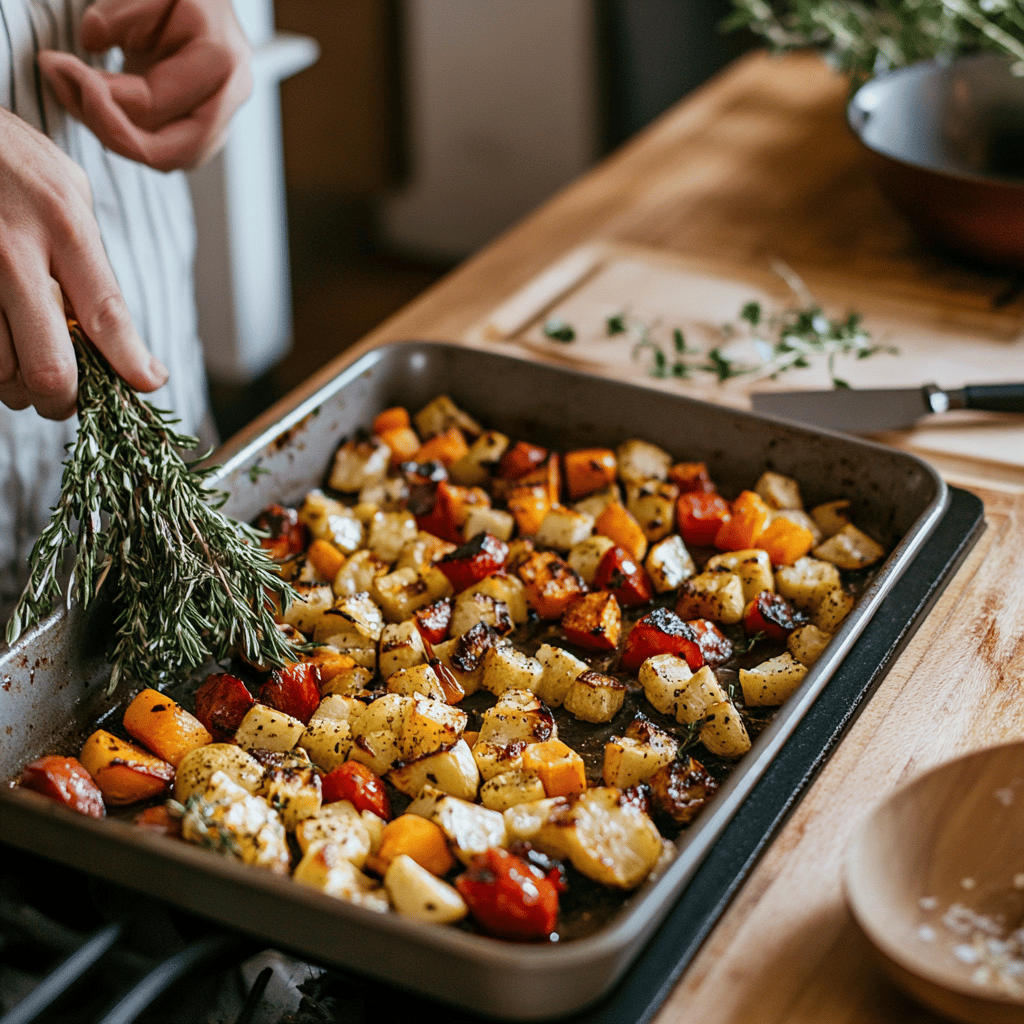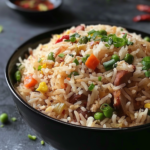The Best Fluffy Pancakes recipe you will fall in love with. Full of tips and tricks to help you make the best pancakes.

The Secret to Extra Crispy Roasted Vegetables Is Already in Your Fridge
Unlock the secret to extra crispy roasted vegetables with ingredients you likely already have in your fridge! Discover tips, tricks, and the magic of kitchen staples that will make your veggie sides the star of any meal.
Introduction
When it comes to cooking, vegetables often get a bad rap. They can be bland, mushy, or just plain unappetizing. However, the missing ingredient that can transform your veggies from soggy to sensational is right in your fridge. In this post, we will explore how to achieve that perfect crispy texture in roasted vegetables, unveiling the secrets that can elevate your side dishes to new heights. Whether you’re aiming for a healthy dinner option, prepping for meal preps, or simply wanting to add some crunch to your plate, this guide will help you master the art of roasting vegetables like a pro.
Why Roast Vegetables?
Roasting vegetables is a cooking method that not only brings out their inherent flavors but also adds delightful textures that can excite your palate. Here’s why you should incorporate roasted veggies into your meals:
- Flavor Enhancement: Roasting caramelizes the natural sugars in vegetables, resulting in a sweeter, deeper flavor.
- Texture Variety: The high heat of roasting encourages crispy exteriors while maintaining tenderness inside.
- Versatile Cooking Method: You can roast nearly any vegetable, and it pairs well with various cuisines and dishes.
- Healthier Alternative: Roasting requires less oil than frying, making it a healthier way to enjoy a variety of vegetables.
The Magic Ingredient: Oil
One of the simplest secrets to achieving that coveted crispy texture is the choice and amount of oil used. Here’s what you need to know:
Choosing the Right Oil
The oil you choose can significantly affect the taste and texture of your roasted vegetables. Some great options include:
- Olive Oil: A popular choice that adds a rich flavor; perfect for Mediterranean-style veggies.
- Canola Oil: A more neutral oil that doesn’t overpower the vegetables.
- Avocado Oil: High smoke point and packed with healthy fats.
- Grapeseed Oil: Great for a light flavor with a high smoke point.
How Much Oil Is Enough?
Using too little oil can result in dry, under-seasoned vegetables, while using too much can lead to sogginess. The key is to find a balance:
– For 4 cups of chopped vegetables, a general guideline is about 2 to 3 tablespoons of oil.
– Toss your veggies until they are lightly coated, ensuring every piece is covered.
The Secret to Extra Crispiness: Use Starch
Did you know that adding a touch of starch can give your roasted vegetables an extra crunch? Here’s how to incorporate this secret ingredient:
Types of Starches to Use
– Potato Starch: A fantastic option for vegetables like sweet potatoes and carrots.
– Cornstarch: Quick to dry out vegetables; just a light dusting before roasting can yield incredible results.
– Rice Flour: Great for cauliflower and broccoli; it helps create a crispy exterior.
How to Apply the Starch
1. After tossing your chopped vegetables in oil, sprinkle a light dusting of your chosen starch over them.
2. Toss again to ensure even coverage.
3. Roast at a high temperature for the best results.
Prep Work: The Importance of Drying Your Vegetables
Moisture is the enemy of crispiness. Before roasting, ensure your vegetables are properly dried:
– **Wash and Soak:** Rinse your vegetables and soak them if necessary (like for mushrooms). This helps in cleaning and softening.
– **Pat Dry:** Use a clean kitchen towel or paper towels to pat them thoroughly until no moisture remains.
– **Air Dry:** Let them sit on a cooling rack for a few minutes to expel any remaining moisture.
High Heat is Key
Crispy roasted vegetables benefit immensely from high heat. Here’s the best temperature for the best results:
Recommended Temperatures
– A general roasting temperature of **425°F (220°C)** allows for the vegetables to cook through while achieving that crispy texture.
– If you want an even char, consider cranking up the heat to **450°F (232°C)**, but keep an eye on them to prevent burning.
Time It Right
Roasting times vary depending on the type and size of the vegetables. Here’s a quick reference guide:
Roasting Time Estimates
– Root Vegetables (Carrots, Beets, and Potatoes): 25-35 minutes
– Cruciferous Vegetables (Broccoli, Cauliflower): 20-25 minutes
– Leafy Greens (Kale, Spinach): 10-15 minutes
– Tender Vegetables (Zucchini, Bell Peppers): 15-20 minutes
Flipping for Even Roasting
To achieve an even roast:
– Halfway through the cooking time, use a spatula to flip the vegetables to ensure all sides crisp up equally.
Seasoning for Flavor
Now that you have the crispy technique down, it’s time to consider flavor. Simple seasoning can go a long way!
Essential Seasoning Suggestions
– Salt: A must for enhancing the natural flavors of vegetables.
– Pepper: Freshly cracked black pepper can add a nice kick.
– Garlic Powder: For that signature savory taste.
– Herbs: Dried herbs like thyme, rosemary, or oregano work well.
– Parmesan Cheese: For a savory finishing touch; sprinkle it on in the last few minutes of roasting.
Experiment with Flavor Profiles
Consider different flavor themes when seasoning your vegetables:
– Italian: Olive oil, garlic, basil, and oregano.
– Mexican: Chili powder, cumin, and lime juice.
– Asian: Soy sauce, sesame oil, and ginger.
Combining Vegetables for the Perfect Roast
Not all vegetables roast at the same rate. Here’s how to group them:
Best Veggie Combinations
– **Root Vegetables:** Carrots, potatoes, sweet potatoes, and beets are great together.
– **Cruciferous Veggies:** Broccoli and cauliflower roast well in combination.
– **Tender Vegetables:** Bell peppers, zucchini, and asparagus can be added as they roast quickly.
Grouping by Size
Cut vegetables into uniform sizes to ensure even cooking. Larger chunks will take longer, while smaller cuts will crisp up faster.
The Importance of Chilling Your Vegetables
If you’re prepping in advance, consider:
– **Chilling Roasted Vegetables:** Allow them to cool completely before storing. This prevents steaming, which can make them soggy.
Enjoying Your Crispy Roasted Vegetables
Once your roasted vegetables are ready, there are countless ways to enjoy them:
Serving Suggestions
– **As a Side Dish:** Pair with grilled meat or fish for a balanced meal.
– **In Salads:** Toss roasted veggies into mixed greens for added texture and flavor.
– **In Wraps or Tacos:** Use them as filling for wraps or tacos for a healthy twist.
– **As Toppings:** Sprinkle over a creamy pasta dish or grain bowl.
Storing Leftovers
If you happen to have leftovers, here’s how to store them:
– Refrigerate in an airtight container for up to 4 days.
– Reheat in the oven to regain that crispy texture, or enjoy them cold in salads.
Conclusion
Now that you have the secrets to achieving extra crispy roasted vegetables, it’s time to get cooking! Don’t be afraid to experiment with different vegetables, oils, and spices to find your perfect combination. Roasting is a delightful way to prepare veggies that not only enhances their flavor but can also add a textural twist to your meals.
If you liked this, check out our recipe for Crispy Garlic Parsley Zucchini Bites for another tasty vegetable preparation that stays true to the theme of delicious crunchiness! Happy roasting!





